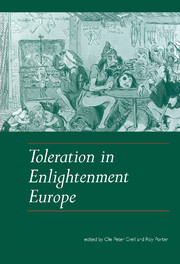Book contents
- Frontmatter
- Contents
- List of contributors
- Preface
- 1 Toleration in Enlightenment Europe
- 2 Toleration and the Enlightenment Movement
- 3 Multiculturalism and Ethnic Cleansing in the Enlightenment
- 4 Intolerance, the Virtue of Princes and Radicals
- 5 Spinoza, Locke and the Enlightenment Battle for Toleration
- 6 Toleration and Enlightenment in the Dutch Republic
- 7 Toleration and Citizenship in Enlightenment England: John Toland and the Naturalization of the Jews, 1714–1753
- 8 Citizenship and Religious Toleration in France
- 9 A Tolerant Society? Religious Toleration in the Holy Roman Empire, 1648–1806
- 10 Enlightenment in the Habsburg Monarchy: History of a Belated and Short-Lived Phenomenon
- 11 Toleration in Eastern Europe: the Dissident Question in Eighteenth-Century Poland–Lithuania
- 12 Toleration in Enlightenment Italy
- 13 Inquisition, Tolerance and Liberty in Eighteenth-Century Spain
- Index
10 - Enlightenment in the Habsburg Monarchy: History of a Belated and Short-Lived Phenomenon
Published online by Cambridge University Press: 03 February 2010
- Frontmatter
- Contents
- List of contributors
- Preface
- 1 Toleration in Enlightenment Europe
- 2 Toleration and the Enlightenment Movement
- 3 Multiculturalism and Ethnic Cleansing in the Enlightenment
- 4 Intolerance, the Virtue of Princes and Radicals
- 5 Spinoza, Locke and the Enlightenment Battle for Toleration
- 6 Toleration and Enlightenment in the Dutch Republic
- 7 Toleration and Citizenship in Enlightenment England: John Toland and the Naturalization of the Jews, 1714–1753
- 8 Citizenship and Religious Toleration in France
- 9 A Tolerant Society? Religious Toleration in the Holy Roman Empire, 1648–1806
- 10 Enlightenment in the Habsburg Monarchy: History of a Belated and Short-Lived Phenomenon
- 11 Toleration in Eastern Europe: the Dissident Question in Eighteenth-Century Poland–Lithuania
- 12 Toleration in Enlightenment Italy
- 13 Inquisition, Tolerance and Liberty in Eighteenth-Century Spain
- Index
Summary
Traditionally, Austrian historiography defines the reign of Maria Theresa, Joseph II and Leopold II (1740–92) as the period of Enlightened Absolutism, whereas the period before 1740, under the rule of Charles VI, could be defined as late Baroque and was characterized by a Counter-Reformist atmosphere. Although one can identify a short-lived influence of enlightened ideas before 1740, the spread of enlightened ideas remained an elitist phenomenon. To understand the intellectual situation in the Habsburg Monarchy we have to glance back briefly at the preceding two centuries. In the sixteenth century, the ideas of Luther's Reformation reached the Habsburg Monarchy very quickly and established themselves firmly. The Reformation – sometimes referred to as the first wave of rationalism in Europe – was adopted, above all, by aristocrats who used it as a weapon against centralism and the incipient absolutism of the Catholic Habsburg dynasty, but it was also taken up by the citizens in the major cities. As the peasant population generally followed the religion of their manorial lords – an Austrian version of the cuius regio, eius religio principle from the religious peace of Augsburg in 1555 – a great part of the population converted to Protestantism in two waves (one in the 1520s and a second one in the 1560s). From the very beginning, the Habsburg rulers did their best to arrest the growing trend toward Protestantism, and somewhat later – in the middle of the sixteenth century – even to reverse the situation. Nonetheless we can estimate that in 1600 approximately 70 per cent of the population in Eastern Austria and up to 90 per cent of the Bohemian inhabitants were no longer Catholics.
- Type
- Chapter
- Information
- Toleration in Enlightenment Europe , pp. 196 - 211Publisher: Cambridge University PressPrint publication year: 1999

